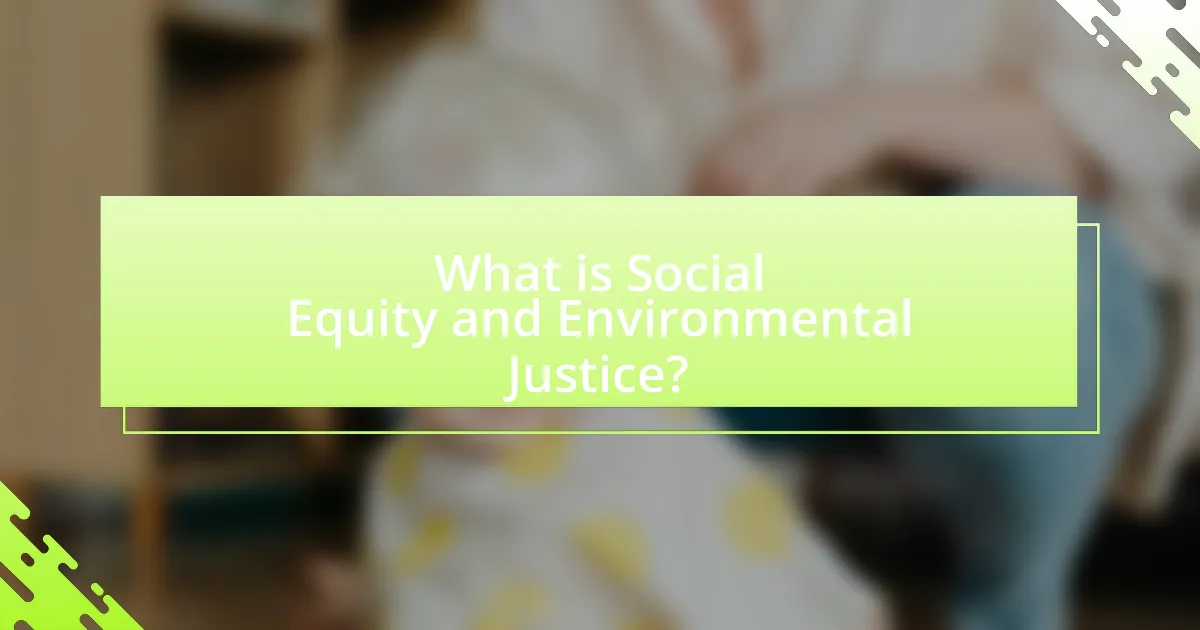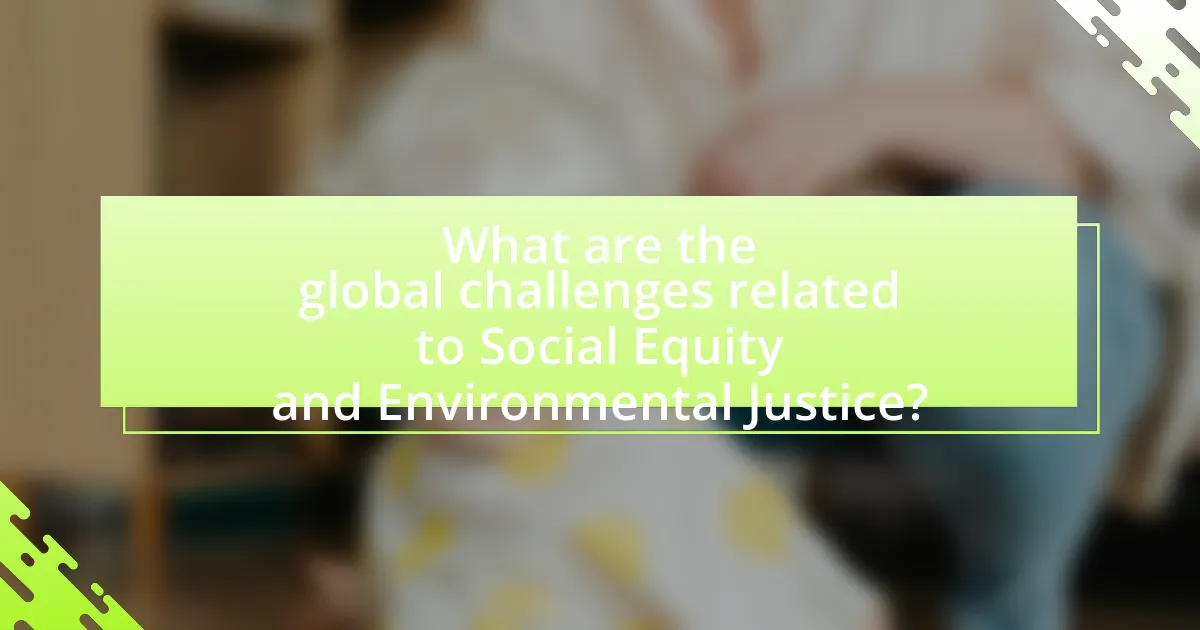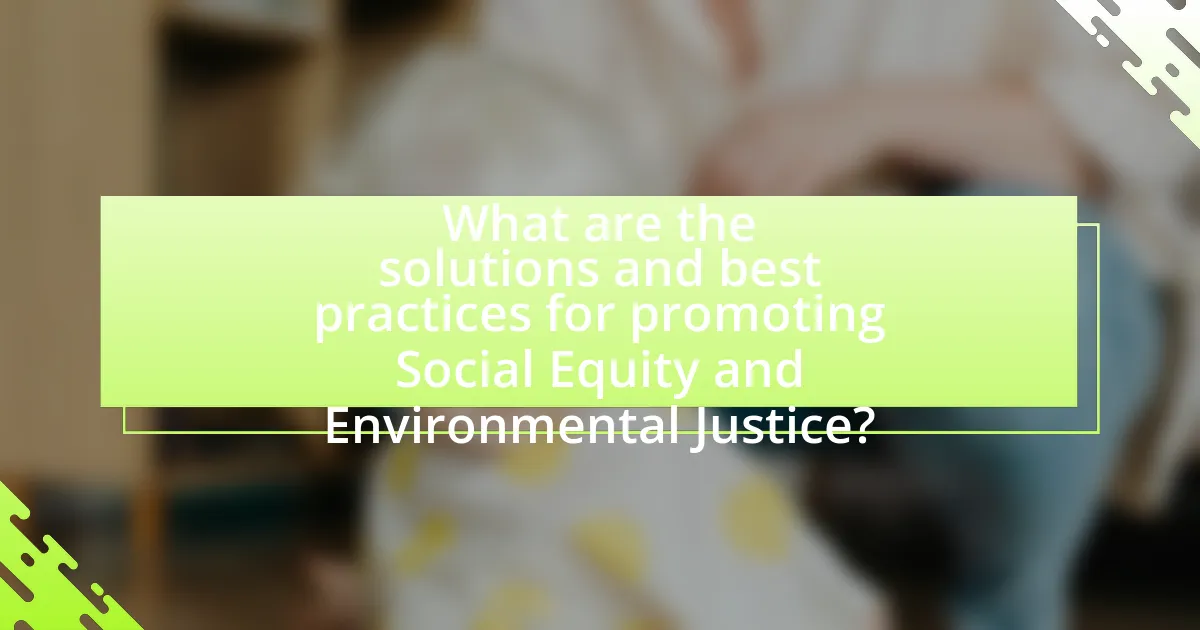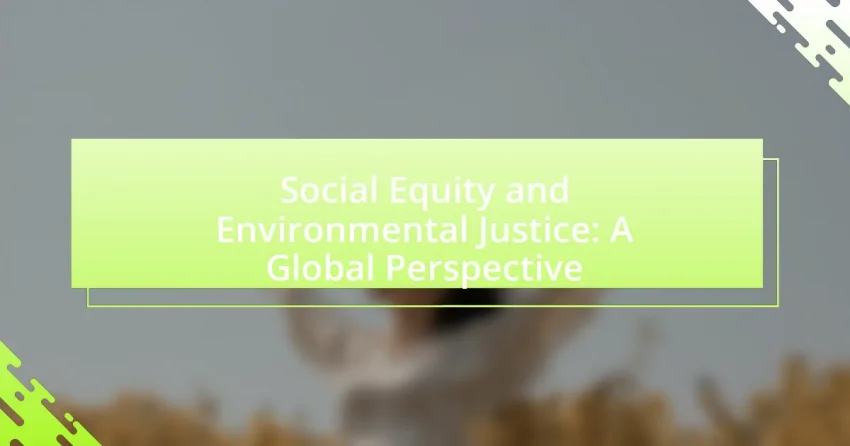Social equity and environmental justice are critical concepts that address the fair distribution of resources and opportunities, particularly for marginalized communities facing disproportionate environmental hazards. This article explores the intersection of these two principles, highlighting their importance in promoting sustainable practices and addressing systemic inequalities. Key topics include the historical context shaping the discourse, the impact of economic disparities and climate change on vulnerable populations, and effective strategies for policy changes and community engagement. Additionally, it examines successful case studies and practical steps individuals can take to advocate for social equity and environmental justice globally.

What is Social Equity and Environmental Justice?
Social equity refers to the fair distribution of resources, opportunities, and privileges within a society, ensuring that all individuals, regardless of their background, have equal access to social, economic, and environmental benefits. Environmental justice is the principle that all communities, particularly marginalized ones, should have equal protection from environmental hazards and equal access to environmental benefits. Together, social equity and environmental justice aim to address systemic inequalities and promote sustainable practices that benefit all populations, as evidenced by studies showing that low-income and minority communities often face disproportionate exposure to pollution and environmental degradation.
How do social equity and environmental justice intersect?
Social equity and environmental justice intersect by addressing the disproportionate impact of environmental hazards on marginalized communities. Social equity focuses on fair treatment and opportunities for all individuals, while environmental justice emphasizes the need for equitable distribution of environmental benefits and burdens. Research indicates that low-income and minority populations often face higher exposure to pollution and environmental degradation, leading to health disparities. For example, a study by the U.S. Environmental Protection Agency found that communities of color are more likely to live near hazardous waste sites, highlighting the intersection of these two concepts. Thus, promoting social equity is essential for achieving environmental justice, ensuring that all communities have equal access to a healthy environment.
What are the key principles of social equity?
The key principles of social equity include fairness, access, participation, and rights. Fairness ensures that all individuals receive equal treatment and opportunities, regardless of their background. Access emphasizes the importance of providing resources and services to marginalized communities, enabling them to overcome barriers. Participation involves engaging diverse groups in decision-making processes, ensuring their voices are heard and considered. Rights highlight the legal and moral entitlements of individuals, advocating for protection against discrimination and injustice. These principles are foundational in promoting social justice and addressing inequalities in various contexts, including environmental justice initiatives.
How does environmental justice address inequalities?
Environmental justice addresses inequalities by advocating for the fair distribution of environmental benefits and burdens across all communities, particularly marginalized groups. This approach recognizes that low-income and minority populations often face disproportionate exposure to environmental hazards, such as pollution and toxic waste. For instance, studies have shown that communities of color are more likely to be located near hazardous waste sites, leading to health disparities. By promoting policies that ensure equitable access to clean air, water, and land, environmental justice seeks to rectify these systemic injustices and empower affected communities to participate in decision-making processes.
Why are social equity and environmental justice important globally?
Social equity and environmental justice are important globally because they ensure fair treatment and meaningful involvement of all individuals in environmental decision-making processes, regardless of race, ethnicity, or socioeconomic status. These principles address systemic inequalities that often lead to marginalized communities bearing a disproportionate burden of environmental hazards, such as pollution and climate change impacts. For instance, studies show that low-income and minority populations are more likely to live near hazardous waste sites, which can lead to severe health issues. By promoting social equity and environmental justice, societies can create sustainable and inclusive policies that protect vulnerable populations and foster resilience against environmental challenges.
What historical events have shaped the discourse on these issues?
The discourse on social equity and environmental justice has been significantly shaped by events such as the Civil Rights Movement in the United States during the 1960s, which highlighted the intersection of race and environmental issues, leading to increased awareness of how marginalized communities are disproportionately affected by environmental hazards. Additionally, the establishment of the Environmental Protection Agency in 1970 marked a pivotal moment in recognizing the need for regulatory frameworks that address environmental injustices. The 1982 protests in Warren County, North Carolina, against the siting of a hazardous waste landfill in a predominantly African American community further galvanized the environmental justice movement, leading to the 1991 First National People of Color Environmental Leadership Summit, which articulated principles of environmental justice. These events collectively underscore the historical context that has shaped contemporary discussions on social equity and environmental justice globally.
How do these concepts impact marginalized communities?
Social equity and environmental justice significantly impact marginalized communities by exacerbating existing inequalities and limiting access to resources. Marginalized groups often face disproportionate exposure to environmental hazards, such as pollution and climate change effects, which can lead to health disparities and economic disadvantages. For instance, a study by the U.S. Environmental Protection Agency found that low-income and minority communities are more likely to live near hazardous waste sites, resulting in higher rates of respiratory diseases and other health issues. Additionally, these communities frequently lack political representation, making it challenging for them to advocate for their rights and access to clean environments. This systemic inequity perpetuates cycles of poverty and disenfranchisement, further entrenching the challenges faced by marginalized populations.

What are the global challenges related to Social Equity and Environmental Justice?
Global challenges related to Social Equity and Environmental Justice include systemic inequality, access to resources, and the disproportionate impact of environmental degradation on marginalized communities. Systemic inequality manifests in various forms, such as economic disparity, racial discrimination, and gender inequality, which hinder equitable access to environmental benefits and resources. Access to clean air, water, and land is often limited for disadvantaged groups, leading to health disparities and reduced quality of life. Furthermore, environmental degradation, exacerbated by climate change, disproportionately affects low-income and minority populations, who typically have fewer resources to adapt or recover from environmental disasters. For instance, studies show that communities of color are more likely to be located near hazardous waste sites, resulting in higher exposure to pollutants and related health issues.
How do economic disparities affect environmental justice?
Economic disparities significantly affect environmental justice by creating unequal access to clean environments and resources. Communities with lower economic status often face higher exposure to pollution, limited access to green spaces, and inadequate infrastructure, which exacerbates health issues and diminishes quality of life. For instance, a study by the Environmental Protection Agency found that low-income neighborhoods are more likely to be located near hazardous waste sites, leading to increased health risks. This inequity highlights how economic status directly correlates with environmental conditions, ultimately undermining the principles of environmental justice that advocate for fair treatment and meaningful involvement of all people in environmental decision-making.
What role does poverty play in environmental degradation?
Poverty significantly contributes to environmental degradation by limiting access to resources and promoting unsustainable practices. Individuals in poverty often rely on immediate natural resources for survival, leading to deforestation, overfishing, and soil degradation as they exploit these resources without sustainable management. For instance, a study by the United Nations Environment Programme indicates that impoverished communities are more likely to engage in practices that harm the environment, such as illegal logging and unregulated waste disposal, due to economic necessity. This cycle perpetuates environmental harm, as degraded ecosystems further exacerbate poverty by diminishing the resources available for livelihoods.
How do wealthier nations contribute to global inequities?
Wealthier nations contribute to global inequities primarily through economic exploitation and unequal resource distribution. These nations often engage in practices such as imposing trade barriers, which limit access to markets for developing countries, and extracting natural resources without fair compensation, leading to environmental degradation and economic instability in those regions. For instance, according to the World Bank, high-income countries account for 80% of global consumption, while low-income countries struggle to meet basic needs, highlighting the disparity in resource allocation. Additionally, wealthier nations frequently influence international policies that favor their interests, perpetuating a cycle of dependency and inequality.
What are the effects of climate change on social equity?
Climate change exacerbates social inequity by disproportionately impacting marginalized communities. These communities often lack the resources to adapt to climate-related challenges, such as extreme weather events, rising sea levels, and food insecurity. For instance, a report by the Intergovernmental Panel on Climate Change (IPCC) highlights that low-income populations are more vulnerable to climate impacts due to limited access to healthcare, housing, and financial resources. Additionally, systemic inequalities in wealth and power hinder their ability to recover from climate disasters, further entrenching social disparities.
How does climate change disproportionately affect vulnerable populations?
Climate change disproportionately affects vulnerable populations by exacerbating existing inequalities and limiting their adaptive capacity. Vulnerable groups, including low-income communities, indigenous peoples, and marginalized ethnic groups, often lack the resources to prepare for and recover from climate-related disasters. For instance, according to the Intergovernmental Panel on Climate Change (IPCC), these populations are more likely to experience severe impacts from extreme weather events, such as floods and droughts, due to inadequate infrastructure and limited access to emergency services. Additionally, they often reside in areas more susceptible to climate hazards, such as coastal zones or regions with poor environmental conditions, further increasing their risk. This systemic disadvantage is compounded by factors such as limited access to healthcare, education, and economic opportunities, which hinder their ability to adapt to changing environmental conditions.
What strategies can mitigate these effects?
Strategies that can mitigate the effects of social inequity and environmental injustice include implementing equitable policy frameworks, enhancing community engagement, and promoting sustainable development practices. Equitable policy frameworks ensure that marginalized communities receive fair access to resources and decision-making processes, which can be supported by data showing that inclusive policies lead to improved social outcomes. Enhancing community engagement fosters collaboration between local populations and policymakers, as evidenced by case studies where participatory approaches have led to more effective environmental management. Promoting sustainable development practices, such as green infrastructure and renewable energy initiatives, can reduce environmental degradation while simultaneously creating economic opportunities for disadvantaged groups, as demonstrated by research indicating that such practices can lead to job creation and improved public health outcomes.

What are the solutions and best practices for promoting Social Equity and Environmental Justice?
Solutions and best practices for promoting social equity and environmental justice include implementing inclusive policy frameworks, engaging marginalized communities in decision-making processes, and ensuring equitable access to resources. Inclusive policy frameworks, such as the United Nations’ Sustainable Development Goals, emphasize the importance of reducing inequalities and promoting sustainable practices. Engaging marginalized communities, as seen in successful initiatives like the Environmental Justice Movement, empowers individuals to voice their concerns and influence policies that affect their lives. Additionally, ensuring equitable access to resources, demonstrated by programs that provide clean water and renewable energy to underserved populations, addresses systemic disparities and fosters resilience. These approaches collectively contribute to a more just and equitable society.
How can policy changes support these goals?
Policy changes can support social equity and environmental justice goals by implementing regulations that ensure fair distribution of resources and protection of vulnerable communities. For instance, policies that mandate environmental assessments before industrial projects can prevent disproportionate impacts on marginalized populations. Research indicates that inclusive policy frameworks, such as the United Nations’ Sustainable Development Goals, emphasize the importance of equity in environmental decision-making, which can lead to improved health outcomes and economic opportunities for disadvantaged groups. By prioritizing community engagement in policy development, governments can create more equitable systems that address historical injustices and promote sustainable practices.
What types of legislation are most effective in promoting equity?
Legislation that effectively promotes equity includes affirmative action laws, anti-discrimination statutes, and social welfare policies. Affirmative action laws, such as the Civil Rights Act of 1964 in the United States, aim to eliminate barriers for marginalized groups in education and employment, leading to increased representation and opportunities. Anti-discrimination statutes, like the Fair Housing Act, prohibit discriminatory practices in housing, ensuring equal access to housing regardless of race, gender, or disability. Social welfare policies, including universal healthcare and income support programs, address economic disparities by providing essential services and financial assistance to disadvantaged populations, thereby promoting overall equity. These types of legislation have been shown to reduce inequality and improve social outcomes, as evidenced by studies indicating that countries with strong anti-discrimination laws experience lower levels of income inequality and better health outcomes among marginalized groups.
How can local governments implement successful initiatives?
Local governments can implement successful initiatives by engaging community stakeholders in the planning and decision-making processes. This approach ensures that initiatives are tailored to the specific needs and priorities of the community, fostering greater public support and participation. For example, the City of Seattle’s Equitable Development Initiative involved extensive community outreach and collaboration with local organizations to address housing and economic disparities, resulting in more effective and inclusive policies. Such evidence demonstrates that when local governments prioritize stakeholder engagement, they enhance the likelihood of successful initiative implementation.
What role do community organizations play in advancing these issues?
Community organizations play a crucial role in advancing social equity and environmental justice by mobilizing local populations, advocating for policy changes, and providing resources and education. These organizations often serve as a bridge between marginalized communities and governmental or institutional entities, ensuring that the voices of those affected by social and environmental issues are heard. For instance, organizations like the Environmental Justice Network have successfully influenced legislation by highlighting the disproportionate impact of environmental hazards on low-income communities and communities of color. Their grassroots efforts have led to increased awareness and action on issues such as pollution, access to clean water, and equitable land use, demonstrating the effectiveness of community-driven initiatives in promoting social equity and environmental justice.
How can grassroots movements influence policy and awareness?
Grassroots movements can influence policy and awareness by mobilizing community members to advocate for specific issues, thereby creating pressure on policymakers. These movements often utilize strategies such as organizing protests, conducting awareness campaigns, and leveraging social media to amplify their messages. For instance, the Civil Rights Movement in the United States effectively changed legislation through grassroots organizing, leading to the Civil Rights Act of 1964. Additionally, research by the Stanford Social Innovation Review highlights that grassroots efforts can lead to significant shifts in public opinion, which in turn can compel government action and policy changes.
What successful case studies exist in this area?
Successful case studies in social equity and environmental justice include the Greenlining Institute in California, which has effectively advocated for equitable access to clean energy and technology for marginalized communities. This initiative has resulted in policies that prioritize environmental benefits for low-income neighborhoods, demonstrating measurable improvements in air quality and access to renewable energy resources. Another notable case is the Just Transition framework employed in various cities, which focuses on transitioning to sustainable economies while ensuring that affected workers and communities receive support and resources. This approach has been implemented in cities like Detroit, where community-led efforts have successfully integrated social equity into urban planning and development, leading to enhanced community resilience and economic opportunities. These examples illustrate the effectiveness of targeted strategies in promoting social equity and environmental justice.
What practical steps can individuals take to promote social equity and environmental justice?
Individuals can promote social equity and environmental justice by actively engaging in community advocacy and supporting policies that address systemic inequalities. For instance, participating in local government meetings allows individuals to voice concerns about environmental issues affecting marginalized communities. Additionally, supporting organizations that focus on environmental justice, such as the NAACP Environmental and Climate Justice Program, can amplify efforts to address disparities. Research shows that communities with active civic engagement see improved policy outcomes related to social equity and environmental health. Furthermore, individuals can educate themselves and others about the impacts of environmental degradation on vulnerable populations, fostering a more informed public that demands equitable solutions.
